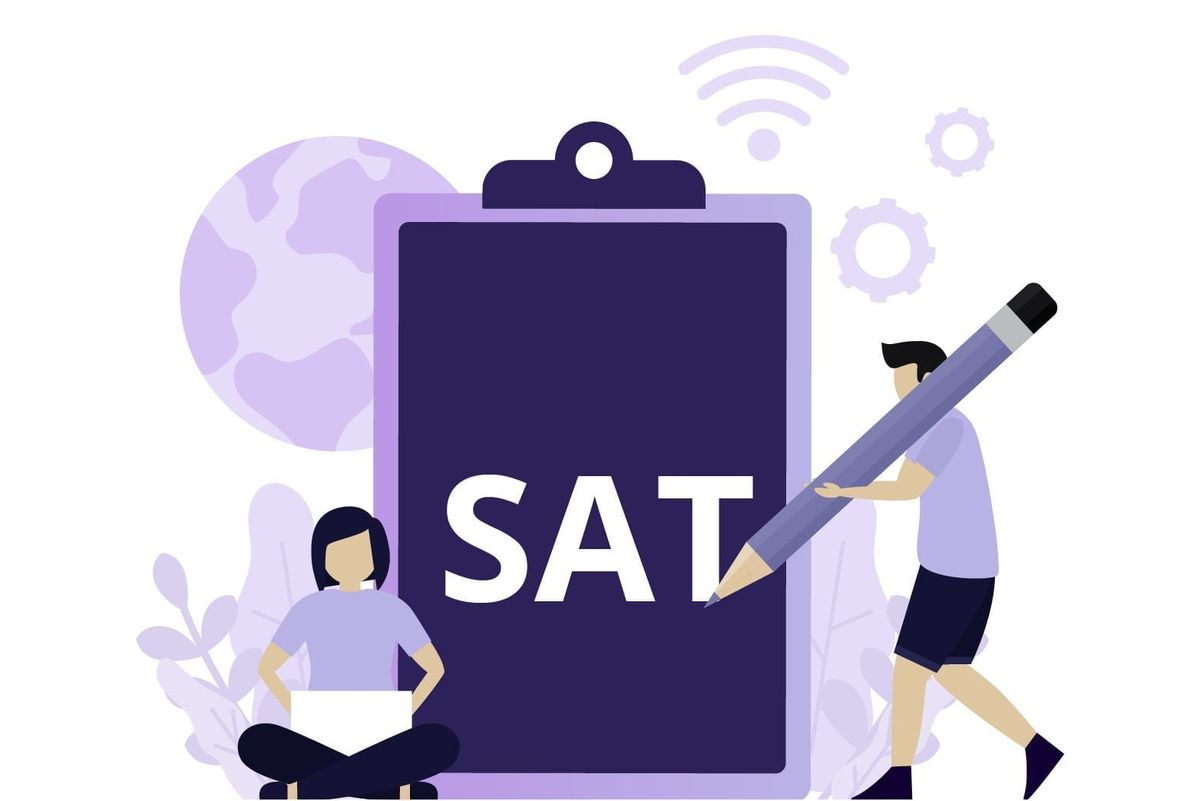According to experts, the ideal SAT score for college applicants varies depending on the chosen schools and other circumstances. A good SAT score is one that enables you to reach your educational objectives, which could be getting accepted into a specific college or earning a merit scholarship to help pay for tuition fees. A score perceived as good for you might be different from a score that is considered good for a classmate, and this is perfectly acceptable.
Taking into account one's individual goals, establishing a target SAT score helps to set a point of focus to maximize opportunities for success.
It’s helpful to understand how the SAT is scored:
- Your total SAT score will be between 400 and 1,600 points
- There are two sections, SAT Math and Evidence-Based Reading and Writing (ERW), and each one is worth 200 to 800 points.
- The percentile shows how your score compares to other students.
- The benchmark score indicates college readiness—the likeliness of passing first-year classes.

A Good SAT Score for College Admissions
It is subjective to determine a strong score, as the expectations of a given institution can differ. According to a report from the College Board, which administers the SAT, the average SAT score for the class of 2021 was 1060, amounting to a nine-point increase from the class of 2020.
This score falls within the range of certain educational institutions, such as Radford University in Virginia, where half of the admitted applicants had an SAT score between 950 and 1150, according to U.S. News data.
Experts recommend that students conduct their research and look up the "middle 50" - the scope of scores between the 25th percentile and 75th percentile for the former year’s admitted students - on each college's website to decide if their score falls within–or surpasses– that range. Once a student knows the score range their target undergrad program accepts, then the student can set their objective score, and if the student hopes to gain a merit scholarship, then set a target score above the school’s average.
Here's a look at the 25th and 75th SAT percentiles in math and reading combined for newly enrolled students in fall 2021 at the top 10 National Universities, as ranked by U.S. News. California Institute of Technology did not report SAT or ACT scores and through 2025 will not consider them during admissions.
SAT score percentiles
The SAT score report contains two percentiles which you can use to compare your performance with that of other test takers. If your score percentile is 50, it means that 50 percent of other test takers achieved a score that is the same or lower than yours.
- Nationally Representative Sample Percentile: This measures your score against all US students in grades 11 and 12, weighted to include those who did not take the test.
- SAT User Percentile: This measures your score against real scores of students from the past three graduating classes who took the current SAT test during high school.
For reference, here's a chart showing the SAT User Percentiles for the total, ERW, and Math scores in 2021.
Benchmark scores
You will be supplied with a benchmark for each of your section scores in the form of color to indicate your college readiness: green, yellow, or red.
- Green: On track
- Yellow: Close to being on track
- Red: Need to strengthen skills
You must keep in mind that a green benchmark score implies a 75% chance of gaining at least a C in the initial semester college course in either Math (algebra, statistics, pre-calculus, calculus) or ERW (history, literature, social sciences, writing).
Consequently, these benchmarks should be taken into consideration as an indicator for pinpointing areas that need attention. However, with the proper perspective and preparation, college success is achievable regardless of the benchmark score.
How to define your target SAT score
One way to see if your SAT score is suitable for admission into your ideal college is to decide on the target score that would boost your chances of being accepted into the schools on your list.
Make a list of schools you’d like to attend.
Write down the names of six to ten schools you’re interested in applying to. Try to include a mix of dream, target, and safety schools.
- If money and qualifications weren’t issues, where would you want to attend? These are your dream schools, also known as reach schools.
- Target schools are those where your grades, test scores, and class rank are similar to the average for the most recently admitted class.
- You should be happy to attend your safety schools, but they should also be schools that you can afford and that you feel confident you’ll be admitted to.
Find each school’s middle 50 percent.
Search for the school name and “SAT score range” to ascertain the middle 50 percent of SAT scores. This range covers the scores from the 25th percentile to the 75th percentile for the incoming students of the most recent class. To put it another way, this is what is retained when you ignore the lowest and highest scores.
Write down these scores for each of your schools. It may be helpful to record the ranges for the Math and ERW sections as well.
For the 2021 admitted class at the University of Michigan, for example, the SAT score middle 50 ranges from 1400 to 1540. This signifies that the middle half of admitted students scored within this range, with the ERW section ranging from 680 to 760 and the Math section ranging from 710 to 790.
Identify your goal SAT score from the list.
List your schools starting with those with the highest score ranges and working your way downward, ending with the lowest score ranges. Schools at the top of the list are likely your dream schools, followed by the target and safety schools in the middle and bottom of the list.
Aim for the 75th percentile score of the school at the top of your list as your SAT target score. Reaching a score near the 75th percentile from the most competitive school on your list should make you competitive with the other schools as well.
Connect with an SAT tutor to increase your chances of success
One tried and true way to increase your chances of success on the SAT is to work with an SAT tutor. One-on-one SAT preparation will enable you to dive into the exam, pinpoint your areas of strength and weakness, and personalize your strategy of attack. If you’re weak in SAT math, for example, a tutor can help you learn the methodology to effectively work through the section and increase your chances of performing well.






